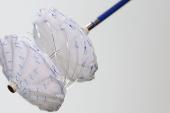PASCAL Pinpoints Patients With Strokes Causally Related to PFO
By factoring in high-risk PFO features, the classification system adds to the RoPE score and will aid clinical decision-making.

For patients with patent foramen ovale (PFO), a novel classification system that factors in high-risk PFO features has the potential to better differentiate who is most likely to benefit from undergoing closure to prevent recurrent stroke, according to new data.
Until now, the 10-point Risk of Paradoxical Embolism (RoPE) score, which is primarily based on age and vascular risk factors, has been routinely used to evaluate the probability of whether a PFO is the cause of cryptogenic stroke.
“But it has several limitations,” lead author David M. Kent, MD, MS (Tufts Medical Center/Tufts University School of Medicine, Boston, MA), told TCTMD. “Because the presence or absence of the PFO is the dependent variable, there was no way to put anatomic and physiologic features of the PFO [like shunt size or presence of an atrial septal aneurysm] into that equation, and everybody recognizes that these things are important.”
The PFO-Associated Stroke Causal Likelihood (PASCAL) Classification System stratifies patients into three categories of causal relatedness—unlikely, possible, and probable—and “incorporates these anatomic and physiologic features, and after doing that, it seems to really improve the performance quite a bit in terms of selecting the patients who can most benefit,” he said.
For the study, published in the December 14, 2021, issue of JAMA, Kent and colleagues include pooled individual patient data from all six randomized clinical trials that compared PFO closure plus medical therapy with medical therapy alone. Among a total of 3,740 participants followed for a median of 57 months, 121 patients had ischemic stroke, translating into an annualized incidence of 1.09% with medical therapy and 0.47% with device closure (adjusted HR 0.41; 95% CI 0.28-0.60).
In subgroup analyses, the PASCAL system was more robustly able to differentiate which patients would have recurrent stroke than the RoPE score.
Likelihood of Ischemic Stroke
|
|
HR |
95% CI |
P for interaction |
|
RoPE Score |
|
|
0.02 |
|
Low |
0.61 |
0.37-1.00 |
|
|
High |
0.21 |
0.11-0.42 |
|
|
PASCAL System |
|
0.003 |
|
|
Unlikely |
1.14 |
0.53-2.46 |
|
|
Possible |
0.38 |
0.22-0.65 |
|
|
Probable |
0.10 |
0.03-0.35 |
|
In patients classified as unlikely, possible, and probable by PASCAL, the 2-year absolute risk reduction of ischemic stroke with device closure as compared with medical therapy was -0.7%, 2.1%, and 2.1%, respectively.
Also, device-associated adverse events were generally higher among patients classified as unlikely by PASCAL. For atrial fibrillation, the absolute risk increases associated with device closure, beyond 45 days after randomization, were 4.41%, 1.53%, and 0.65% in the unlikely, possible, and probable PASCAL categories, respectively.
‘Quantitative and Scientific Approach’
Speaking with TCTMD, Robert W. Yeh, MD, MSc (Beth Israel Deaconess Medical Center, Boston, MA), who wrote an accompanying editorial with Doreen DeFaria Yeh, MD (Massachusetts General Hospital, Boston), said this study “adds tremendously to the literature because in many ways it provides a quantitative and scientific approach to something which I think clinicians knew intuitively to be true, which was there are some patients who benefit from this and other patients who don't.”
Further, the editorialists write that the data “provide critical evidence that can immediately influence the clinical evaluation and care of patients with cryptogenic stroke and PFO.”
According to Kent, the PASCAL system is “really ready for prime time now,” but he added that “clinical decision-making is not always strictly algorithmic.”
“A lot has to do especially with patient preferences, so it’s even possible that patients that fall into the high benefit PASCAL probable group might prefer just to be treated with medicine and not with a device,” he continued. “It's also possible that patients who fall in the unlikely group might opt to get a device even though the benefits seem to be negligible, and the risks seems to be present.”
It should be an easy system for clinicians to use, Kent said, given that “almost all” of the variables that go into PASCAL are routinely ascertained. “To use PASCAL, you just need to know the RoPE score and you need to know some of the echocardiographic features such as the size of the shunt and the presence of the ASA [atrial septal aneurysm]. One of the changes might be that these transesophageal echos that are done for these patients might have to be done more carefully in routine practice than they might be done at some places now.”
Specifically, measuring shunt and ASA size is routinely performed, but “maybe people just need to do them in a way that's more similar to how they were done in the clinical trials,” Kent suggested.
The main reason that having a more-specific classification is so important relates back to how clinicians can counsel patients, he said. “All guidelines recommend that you provide more-individualized estimates of the risks and benefits of device therapy versus medical therapy, but we really had no good way of doing that until now,” Kent explained. “We do want to limit unnecessary procedures. We do want to limit the placement of unnecessary devices that aren't benefitting the patients. And this is something that can really help target the therapy to the patients who most benefit.”
Yeh agreed. “These patients are incredibly anxious,” he told TCTMD. “The anxiety associated with having a stroke and knowing that there’s a ‘hole in your heart’ that may or may not have been responsible for it can be so high. So you really want to make sure that you bring all the expertise to bear. And by the same token, the procedure is not risk-free. If it were a risk-free procedure, then you'd say, ‘Okay, well it doesn't really matter, let's just do it.’”
As of now, Yeh said, the most-recent randomized trials on PFO closure and recurrent stroke prevention “haven't necessarily closed the book, . . . but they have certainly clarified a lot of the science.” From here, the last big unanswered questions have to do with appropriate medical therapy for those who don’t undergo closure, he said. “It could be antithrombotic or oral anticoagulation therapy. What is the duration of that therapy? Does that mean lifelong? Is it antiplatelet therapy? Is that really sufficient depending on the etiology?”
Kent said this is where he, too, would like to see the research go next. Additionally, one outstanding question is whether patients who are over 60 and have high-risk PFO features like large shunt or an ASA and otherwise favorable RoPE score benefit from closure. Patients in the current analysis were between age 18 and 60. “Maybe studying this group might be worthwhile,” he said.
Yael L. Maxwell is Senior Medical Journalist for TCTMD and Section Editor of TCTMD's Fellows Forum. She served as the inaugural…
Read Full BioSources
Kent DM, Saver JL, Kasner SE, et al. Heterogeneity of treatment effects in an analysis of pooled individual patient data from randomized trials of device closure of patent foramen ovale after stroke. JAMA. 2021;326:2277-2286.
Yeh RW, DeFaria Yeh D. Patent foramen ovale closure—harnessing clinical trial evidence to inform individualized treatment decisions. JAMA. 2021;326:2265-2267.
Disclosures
- Kent reports receiving grants from the Patient-Centered Outcomes Research Institute and WL Gore during the conduct of the study and speaker honoraria from the Canadian Stroke Consortium outside the submitted work.





Comments